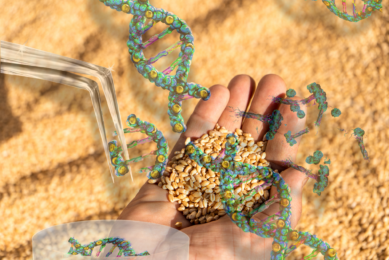First generation GM derived feeds are safe
Results from more than 100 animal studies show that there are no significant differences in the nutritional value of feeds from genetically modified plants (GMP) of the first generation in comparison with non-GMP varieties.
To date, no fragments of recombinant DNA have been found in any organ or
tissue sample from animals fed GMP. The lower content of mycotoxins in Bt-maize
and side effects in GMP of the second generation are of safety
concern.
These conclusions were made in the recently published paper
“Studies on feeds from genetically modified plants (GMP) – Contributions to
nutritional and safety assessment” in Animal Feed Science and Technology.
Authors were G. Flachowsky, from the Institute of Animal Nutrition of the
Federal Agricultural Research Centre (FAL) in Braunschweig, Germany. He was
co-authored by H. Böhme and I. Halle from the same institute and K. Aulrich from
the Institute of Organic Farming of FAL.
The results indicate that
routine feeding studies with target animal species add little to nutritional
assessment of feed from GMP of the first generation, but they are of public
interest and important for safety assessment. These studies will play a more
important role in nutritional and safety assessment of feeds from GMP with
output traits. Proposals for such studies were made on the basis of previous
experiments.
Since 1997, 18 studies with feeds from genetically modified
plants (GMP) in the nutrition of dairy cows, growing bulls, growing and
finishing pigs, laying hens, chicken for finishing as well as growing and laying
quails were conducted at the Federal Agricultural Research Centre (FAL) in
Braunschweig (Germany).
The majority of the experiments (16) were
undertaken with GMP of the so-called first generation (plants with input traits
and without substantial changes in composition) such as Bt-maize, Pat-maize,
Pat-sugar beet, Gt-soybean, Gt-potatoes and Bt-potatoes.
Two studies were
carried out with GMP of the second generation (plants with output traits or with
substantial changes in their chemical composition) such as an altered fatty
acids profile in rapeseed or inulin potatoes. In all experiments, feeds from GMP
were compared with their isogenic counterparts.
The iso- and transgenic
feeds were analysed for their composition (proximates, fibre fraction, amino
acids, fatty acid pattern, minerals) and undesirable substances (e.g.,
mycotoxins).
Animal studies were carried out for nutritional and safety
assessment such as digestibility, feed intake, health and performance of target
animal species and quality of food of animal origin.
Reproduction was
studied in a 10-generation experiment with quails and a 4-generation experiment
with laying hens. Duration of experiments and number of animals were limited in
some cases due to small amounts of GM-feed available for
experimentation.
Attention was drawn to the fate of DNA during feed
processing (silage making, oil extraction), in the digestive tract of animals
(slaughtering of animals 0, 4, 8, 12 and 24 h after feeding) and in the animal
body (samples from several organs and tissues).
In agreement with more
than 100 animal studies available to date, results show no significant
differences in the nutritional value of feeds from GMP of the first generation
in comparison with non-GMP varieties. To date, no fragments of recombinant DNA
have been found in any organ or tissue sample from animals fed
GMP.
Source: Animal Feed Science and Technology, Volume 133, Issues 1-2 , 1 February 2007, Pages 2-30.











